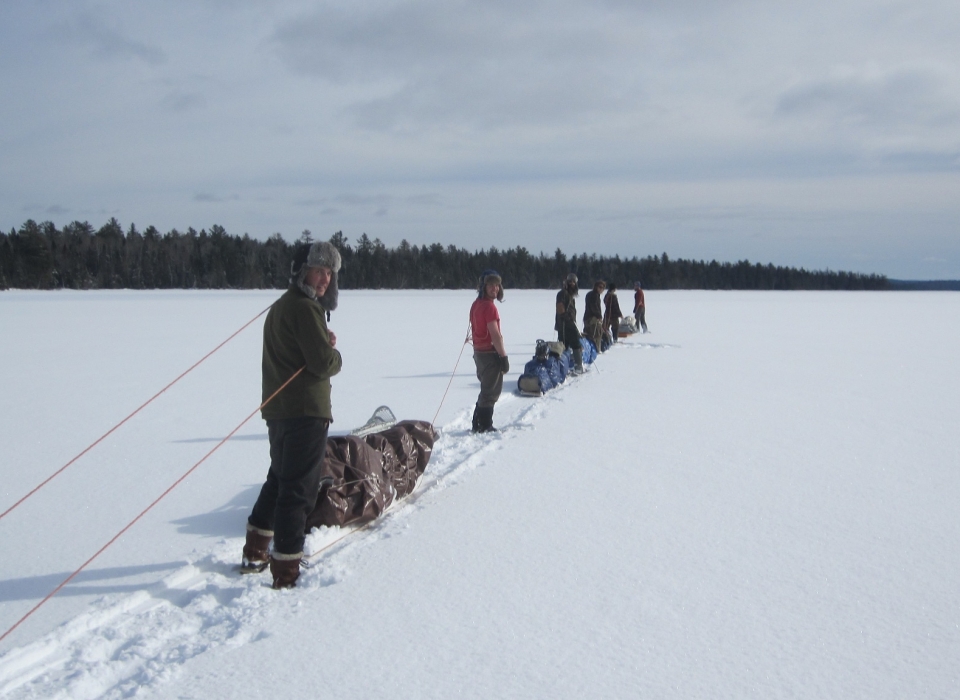Traditional Winter Camping & Snowshoe Expeditions
Toboggans, Canvas Tents, Wood Stoves, Traditional Skills
Winter in the northern bush is a magical time, when all the bugs and people have settled down for the season. When frozen and covered with snow, the waterways and low-lying areas make ideal routes for travel. Burdens are easily transported by toboggan or sled, and the whole of the frozen north suddenly becomes within walking distance.
Northern Winter Skills
Our techniques and philosophy for the winter trail come from those who routinely spent entire winters in the bush. From them we’ve learned to live with a grace and economy unheard of in modern winter camping. We see it as a sign of intelligence and sophistication to be warm and comfortable while living and traveling in weather that is frequently below zero degrees (F).
Traditional Winter Gear
Our traditional winter gear allows us to live in relative luxury during our time in the field. We have four different styles of canvas tents, two of which are made from Egyptian cotton. The tents are outfitted with wood stoves, allowing us to warm and dry ourselves and our gear daily, as well as cook inside the tents during periods of bad weather. We transport everything on homemade toboggans. We make these ourselves, out of both wood and plastic. We also use homemade runnered sleds. Such traditional gear allows us to be mobile, self-sufficient, and comfortable while in the bush.
Our Teaching And Expedition Experience
We’ve been running multi-week snowshoe expeditions since becoming a full-time operation in 1999. In that time we’ve introduced many people to the gear and experience of living out during winter. Our longest-running winter program is the Boreal Snowshoe Expedition, a 2-week snowshoe expedition. We also offer other shorter trips.
What The Winter Experience Is Like
Our days start with the wood stove being stoked, and the resulting warmth coaxing people out of their sleeping bags. Coffee and breakfast is soon on the stove, and after a nourishing meal we pack up camp or explore the surrounding territory. Lunch is an easily prepared meal that often takes place away from camp, complete with kettles of tea and coffee. At supper we have freshly baked bannock and often finish with a bucket of snow cream. After darkness falls, the tents are illuminated with candles. The light is reflected by the white cotton of the tent, creating a cheerful atmosphere. The winter night sky has treasures to show us. When the constellation Orion is visible, 9 of the 21 first-magnitude stars are visible, creating a breathtaking feast for the eyes. Settling in amongst the tranquility of the winter forest, we sink into sleep one by one, until the tent is quiet and only the whispers of the forest can be heard.
It is common for people to be surprised at how comfortable winter can be with the proper knowledge and gear. Many are the nights I have drifted off to sleep after seeing the northern lights dance across the sky, listening to the song of coyotes in the distance, and warmed by the heat of the wood stove.
More Information On Snowshoeing And Winter Expeditions
For more information on life on the snowshoe trail, check out these articles and pages:
- Snowshoe Primer
- Dan Fisher’s Trip Journal From February, 2001
- No Sleeping Bag Winter Trip, February 2002
- Winter Footwear: Mukluks And Rubber Boots
Also check our blog for more articles, podcasts and videos about winter trips.









